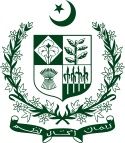
Back পাকিস্তানের সাধারণ নির্বাচন, ১৯৯০ Bengali/Bangla Parlamentswahlen in Pakistan 1990 German Élections législatives pakistanaises de 1990 French Pemilihan umum Pakistan 1990 ID Парламентские выборы в Пакистане (1990) Russian پاکستان کے عام انتخابات 1990ء Urdu 1990年巴基斯坦大選 Chinese 第5屆巴基斯坦下議院選舉 ZH-YUE
| |||||||||||||||||||||||||||||||
All 217 seats in National Assembly 109 seats seats needed for a majority | |||||||||||||||||||||||||||||||
|---|---|---|---|---|---|---|---|---|---|---|---|---|---|---|---|---|---|---|---|---|---|---|---|---|---|---|---|---|---|---|---|
| Turnout | 45.17% | ||||||||||||||||||||||||||||||
| |||||||||||||||||||||||||||||||
 Winning party by constituency | |||||||||||||||||||||||||||||||
| |||||||||||||||||||||||||||||||
 |
|---|
|
|
General elections were held in Pakistan on 24 October 1990 to elect the members of the National Assembly. The elections were primarily a contest between the People's Democratic Alliance (PDA, a four party alliance led by the ruling Pakistan Peoples Party (PPP) of Benazir Bhutto) and the conservative nine-party alliance, Islami Jamhoori Ittehad (IJI) headed by Nawaz Sharif.
President Ghulam Ishaq Khan dissolved the National Assembly and dismissed Bhutto's government in August 1990 on charges of corruption and maladministration.[1] However, the PPP was still extremely popular and there was a fear amongst anti-PPP forces that it might be re-elected. Numerous steps were taken by Ishaq with help of the military establishment to sway the results in favour of the IJI, including the appointment of IJI chairman Ghulam Mustafa Jatoi as caretaker Prime Minister.[2] Despite their efforts, the PPP remained ahead in opinion polls.[3]
However, the result was a surprise victory for the IJI, which won 111 of the 207 general seats (a further ten were reserved for minority voters). The PDA won just 44 seats amidst a voter turnout of only 45%. The IJI's parliamentary leader Sharif became Prime Minister while Bhutto became the Opposition Leader. In 2012 the Supreme Court ruled that the elections had been rigged.[3]
- ^ A Leaf From History: Ghulam Ishaq invokes Article 58-2(b), sends Benazir packing Dawn, 15 January 2017
- ^ An overview of 1990 general elections: The game gets dirtier Dawn, 12 April 2013
- ^ a b 1990 election was rigged, rules SC Dawn, 19 October 2012



